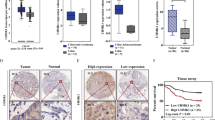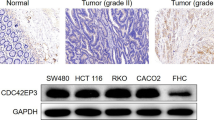Abstract
Akt2 overexpression correlates with chemoresistance of colorectal cancer (CRC). However, the cellular functions and precise signals elicited by Akt2 in LSCC have not been elucidated. Here, we transfected a CRC cell line HCT116 with Akt-2 targeted shRNA in order to establish a cell line with Akt2 knockdown. In vitro experiments showed that knockdown Akt2 in HCT116 cells was associated with decrease in cell proliferation as well as enhanced cell apoptosis. Furthermore, our results demonstrated that Akt2 knockdown correlated with elevated chemosensitivity of HCT116 cells to paclitaxel. Importantly, we found that knockdown of AKt2 resulted in downregulation of MDR-1 and MRP-1. Our findings may lead to a better understanding of the biological effect of Akt2 and may provide mechanistic insights for developing potential therapeutic strategies targeting AKt2.



Similar content being viewed by others
References
Glimelius, B., et al. (2003). A systematic overview of radiation therapy effects in rectal cancer. Acta Oncologica, 42(5–6), 476–492.
Li, J., et al. (2011). miR-203 reverses chemoresistance in p53-mutated colon cancer cells through downregulation of Akt2 expression. Cancer Letters, 304(1), 52–59.
Ades, S. (2009). Adjuvant chemotherapy for colon cancer in the elderly: moving from evidence to practice. Oncology (Williston Park), 23(2), 162–167.
Hanada, M., Feng, J., & Hemmings, B. A. (2004). Structure, regulation and function of PKB/AKT–a major therapeutic target. Biochimica et Biophysica Acta, 1697(1–2), 3–16.
Cui, Y., et al. (2012). Knockdown of AKT2 expression by RNA interference inhibits proliferation, enhances apoptosis, and increases chemosensitivity to the anticancer drug VM-26 in U87 glioma cells. Brain Research, 1469, 1–9.
Ericson, K., et al. (2010). Genetic inactivation of AKT1, AKT2, and PDPK1 in human colorectal cancer cells clarifies their roles in tumor growth regulation. Proceedings of the Nationail Academy of Science U S A, 107(6), 2598–2603.
Wang, J., et al. (2012). Knockdown of cyclin D1 inhibits proliferation, induces apoptosis, and attenuates the invasive capacity of human glioblastoma cells. Journal of Neuro-oncology, 106(3), 473–484.
Zhang, G., et al. (2011). Knockdown of Akt sensitizes osteosarcoma cells to apoptosis induced by cisplatin treatment. International Journal of Molecular Sciences, 12(5), 2994–3005.
Cantley, L. C. (2002). The phosphoinositide 3-kinase pathway. Science, 296(5573), 1655–1657.
Chin, Y. R., & Toker, A. (2009). Function of Akt/PKB signaling to cell motility, invasion and the tumor stroma in cancer. Cellular Signalling, 21(4), 470–476.
Andjelkovic, M., et al. (1997). Role of translocation in the activation and function of protein kinase B. Journal of Biological Chemistry, 272(50), 31515–31524.
Borgatti, P., et al. (2003). Threonine 308 phosphorylated form of Akt translocates to the nucleus of PC12 cells under nerve growth factor stimulation and associates with the nuclear matrix protein nucleolin. Journal of Cellular Physiology, 196(1), 79–88.
Calera, M. R., et al. (1998). Insulin increases the association of Akt-2 with Glut4-containing vesicles. Journal of Biological Chemistry, 273(13), 7201–7204.
Kupriyanova, T. A., & Kandror, K. V. (1999). Akt-2 binds to Glut4-containing vesicles and phosphorylates their component proteins in response to insulin. Journal of Biological Chemistry, 274(3), 1458–1464.
Roy, H. K., et al. (2002). AKT proto-oncogene overexpression is an early event during sporadic colon carcinogenesis. Carcinogenesis, 23(1), 201–205.
Coffer, P. J., & Woodgett, J. R. (1992). Molecular cloning and characterisation of a novel putative protein-serine kinase related to the cAMP-dependent and protein kinase C families. European Journal of Biochemistry, 205(3), 1217.
Morini, M., et al. (2000). The alpha 3 beta 1 integrin is associated with mammary carcinoma cell metastasis, invasion, and gelatinase B (MMP-9) activity. International Journal of Cancer, 87(3), 336–342.
Yuan, Z. Q., et al. (2003). AKT2 inhibition of cisplatin-induced JNK/p38 and Bax activation by phosphorylation of ASK1: implication of AKT2 in chemoresistance. Journal of Biological Chemistry, 278(26), 23432–23440.
Bellacosa, A., et al. (1995). Molecular alterations of the AKT2 oncogene in ovarian and breast carcinomas. International Journal of Cancer, 64(4), 280–285.
Liao, Y., et al. (2003). Increase of AKT/PKB expression correlates with gleason pattern in human prostate cancer. International Journal of Cancer, 107(4), 676–680.
Djeu, J. Y., & Wei, S. (2009). Clusterin and chemoresistance. Advances in Cancer Research, 105, 77–92.
Argov, M., et al. (2010). Novel steroid carbamates reverse multidrug-resistance in cancer therapy and show linkage among efficacy, loci of drug action and P-glycoprotein’s cellular localization. European Journal of Pharmaceutical Sciences, 41(1), 53–59.
Author information
Authors and Affiliations
Corresponding author
Rights and permissions
About this article
Cite this article
Ding, Z., Xu, F., Li, G. et al. Knockdown of Akt2 Expression by ShRNA Inhibits Proliferation, Enhances Apoptosis, and Increases Chemosensitivity to Paclitaxel in Human Colorectal Cancer Cells. Cell Biochem Biophys 71, 383–388 (2015). https://doi.org/10.1007/s12013-014-0209-9
Published:
Issue Date:
DOI: https://doi.org/10.1007/s12013-014-0209-9




